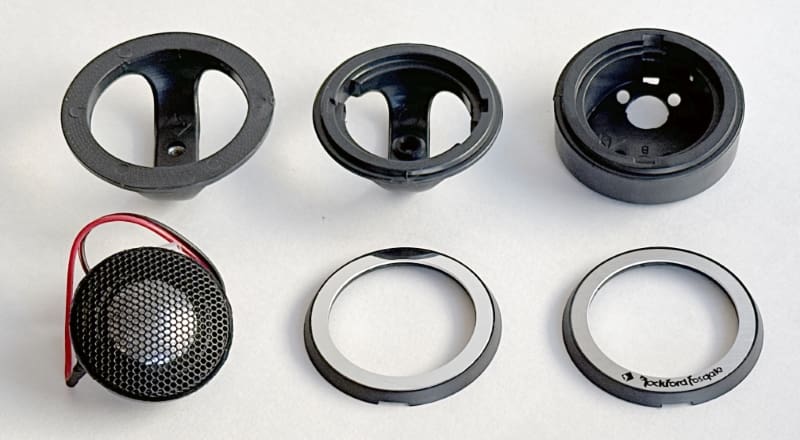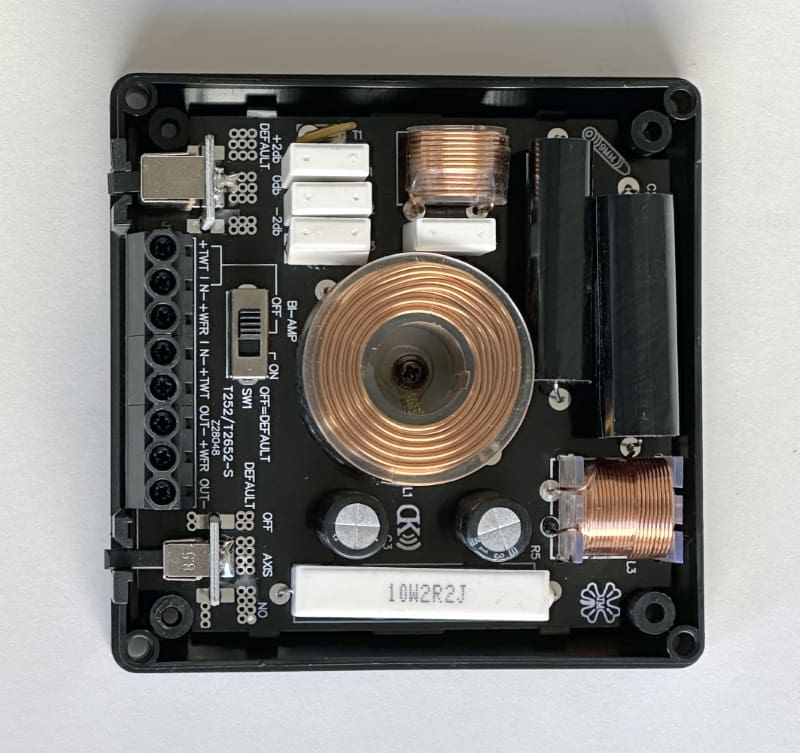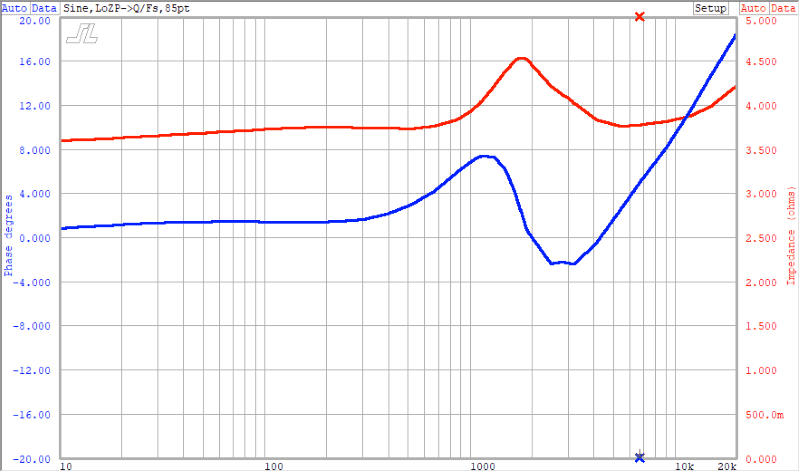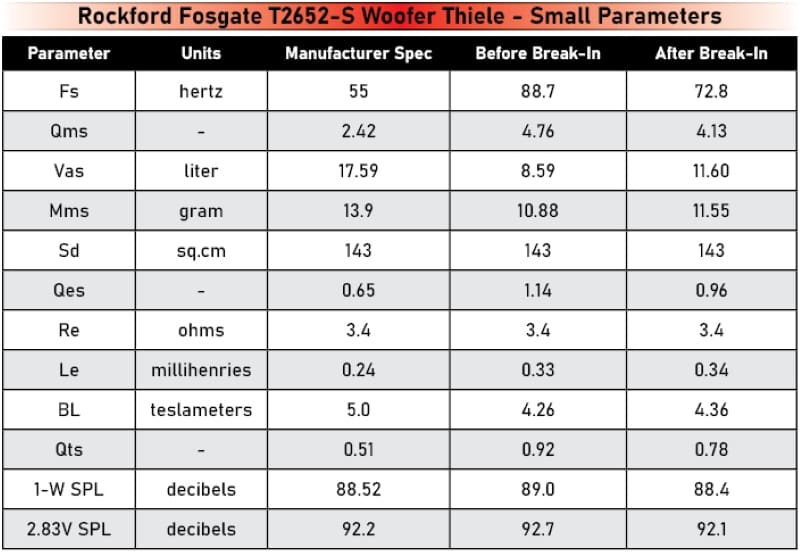Over the past few years, I’ve been fortunate to review the T4652-S and T3652-S Power Series component sets from Rockford Fosgate. The company’s thorough understanding of how speakers work led them to include technologies that allowed these speakers to outperform so-called audiophile products from some of the top boutique brands. I have a set of the more affordable Power Series T2652-S 6.5-inch components for this Test Drive Review in the lab. Let’s check them out.
Features of the Rockford Fosgate T2652-S Component Set
There are four performance levels of speakers in the Power Series. The ultra-smooth and detailed T4652-S are the flagships. The clean and powerful T3652-S set was designed to rock ’n’ roll like few others. The next down in the series are these T2652-S components. The system includes a pair of 6.5-inch woofers, a pair of aluminum dome tweeters, premium passive crossover networks, 5×7/6×8 mounting adapter plates, grilles for the woofers and mounting hardware for the tweeters. All your installer will need is to add a bit of speaker wire to connect everything to your amplifier, and you’ll be in business.
The T2652-S set is rated to handle 100 watts of power continuously, with the MAX power handling being 200 watts. Frequency response is specified at 55 Hz to 22 kHz, and efficiency is 89 dB. The set has a nominal impedance of 4 ohms. The woofers require 2.51 inches of clearance from the mounting surface. The tweeters need 0.5 inch of mounting depth when flush-mounted. The passive crossover network filters the tweeter at 3 kHz with an -18 dB/octave filter and the woofer at the same frequency with a -12 dB/octave filter.

The woofers are based around a StampCast basket. The basket (also called a frame) is stamped steel but bears the design and strength of a cast solution without the added expense. FlexFit mounting slots in four locations allow the driver to work with many OEM fastener locations. A pre-installed, closed-cell foam gasket on the mounting surface ensures a good seal. A plastic reinforcing ring on top of the mounting lip keeps the hardware from damaging the butyl rubber surround. The basket includes cooling vents under the spider mounting ledge for increased power handling and to prevent pressure build-up at high excursion levels.
The woofer cones feature injection-molded, carbon fiber-reinforced polypropylene construction. The microscopic carbon fiber strands add rigidity, damping and thermal stability to the assembly for solid bass and smooth midrange performance. The cone is attached to the basket with a rubber surround using Rockford Fosgate’s Vertical Attach Surround Technique. This design increases cone area without affecting the mounting and cutout requirements. These 6.5-inch woofers have an effective surface area of 143 square centimeters. Popular competing products are around 128 square centimeters. That’s about 10% more cone area to provide improved efficiency and better bass response. A machined aluminum phase plug is in the center of the driver.

The motor features a fixed ceramic magnet with a 1.2-inch high-temperature aluminum voice coil in the center. A linear poly-cotton spider provides lower compliance and cone centering. Impressively, the Xmax10 on the woofer is 6.6 millimeters. Unlike most Xmax specifications, which use calculations based on the top plate’s thickness and the voice coil’s height, Rockford Fosgate uses a laser velocity measurement to determine the excursion level that produces 10% THD for their Xmax number. That’s pretty cool. All car audio companies should do this.
The tweeters in the T2652S set feature an aluminum dome design with an integrated mylar phase plug. Each tweeter uses a compact neodymium magnet for good efficiency. Electrical connections are made via pigtails with female quick-connect terminals. Mounting hardware for the tweeter includes Discrete Dual Clamp surface, flush and angle-mount hardware, so your installer can get those tweeters on-axis with the listening position in almost any vehicle. You can also choose chrome finishing rings with the Rockford Fosgate logo in white or black.

The passive crossover networks include bi-amp wiring options, tweeter output level, and on/off-axis switches. Five percent tolerance polypropylene capacitors and air-core inductors ensure smooth output, even at impressive power levels. The network design uses Butterworth alignments with a -12 dB/octave low-pass filter on the woofer and a -18 dB/octave high-pass filter on the tweeter. An internal switch lets your installer turn the bi-amp connections on and off. Externally accessible slide switches change the response for on- and off-axis tweeter mounting and the tweeter output level.

T2652-S Inspection and Measured Parameters
I started the test process by measuring the Thiele/Small parameters of the new woofers straight out of the box. I then set them up on my test bench and fed them with a 36-hertz test tone to break in the suspension. After about eight hours of exercise, I let them cool and repeated the measurements. The resonant frequency dropped significantly, and the compliance increased accordingly.

I measured the impedance of the tweeter without the crossover. It showed a nominal 4-ohm impedance and a resonant frequency of 1.82 kHz. The impedance graph was smooth, with minimal high-frequency inductance.

The woofer specifications on the website don’t align with the as-measured specifications in terms of outright numbers, but the predicted performance is very similar. I checked with the transducer engineering team at Rockford Fosgate, and they confirmed that the change was intentional. This increase in Fs would increase efficiency. They also confirmed that the numbers match their measurements, and all are well within the tolerance range. As they say, “Features and specifications are subject to change.” This is a good thing.

Auditioning the Rockford Fosgate T2652-S
I set the T2652-S speakers up in one of my 2.2-cubic-foot test enclosures with the tweeter about 4 inches above the woofer. Before taking measurements, I do my listening tests to help ensure that I won’t skew my observations. I’ll only listen to the single speaker set during speaker evaluations rather than the pair. This type of listening simplifies picking out characteristics specific to frequency response and distortion.
The first track I listened to was “Brian Wilson” by the Barenaked Ladies. I started with the woofer and tweeter directly on-axis with the listening position. This orientation had a bit too much upper midrange for my liking. As an experiment, I rotated the speaker cabinet by about 15 degrees to see if that would calm things down. The midrange output was indeed reduced. This change in frequency response is common with component speaker sets that use passive crossovers. We rarely listen to speakers on-axis in our vehicles, so it appears the crossover networks are optimized for that configuration.
The T2652-S set, like the T3652-S set, was engineered deliberately to make itself heard, even if the system has powerful subwoofers. The amount of midrange isn’t excessive; it’s more of a tuning preference. Vocals still sound full and rich but stand out ever so slightly from the mix. The guitar solo around 4:00 was clear, with good detail from each string pluck.
Up next was “Two Tribes (Annihilation Mix)” by Frankie Goes to Hollywood. I use this track to evaluate midbass dynamics and clarity. The T2652-S had a great attack and a nice sense of warmth. The speakers aren’t dry and analytical but aren’t sloppy and uncontrolled. The kick drum and male vocal had more midbass than I expected. The low-frequency information in the synthesizer comes through a bit thin in the listening room, but the transfer function in a car would boost those frequencies nicely.
I increased the volume significantly and restarted the track. The T2652-S soaked up most of what the 300-watts-per-channel amplifier was dishing out. Some straining was evident as the woofer tried to reproduce that 35-hertz rumble at this volume level. Getting the most out of this track requires a subwoofer.
Now, for something a bit tweaky, I played “I Can See Clearly Now” by the Holly Cole Trio. Holly’s voice was reproduced well with that slight emphasis in the upper midrange. It’s not to the point of being bright or harsh, just forward in the playback. The piano sounded very realistic across the entire range. As found with the other tracks, the lower notes of the upright bass are a bit thin. These low notes are centered around 55 hertz, well below where the front speakers in a premium audio system would play.
The last track was “Brothers in Arms” by Dire Straits. Mark Knopfler’s voice sounds good, with some richness in the lower midrange. The upper midrange frequencies remain slightly forward. A few guitar notes stood out from the others, but not to the point that you’d wince.
The T2652-S set is like the T3652-S in terms of balance. It’s not shy about offering the ability to make vocals clearly audible in any system. The tweeter is of the same genre, with high-frequency output that ensures that every crash, ring and resonance is precise and detailed. If you have a system with subwoofers and you like a lot of bass but still want to hear the vocals and instruments, these speakers are a great choice. As my friend Stephen would say, “This sh!t talks!” – which is quite the compliment.

Rockford Fosgate T2652-S Measurements
With the listening done, it was time to make the acoustic measurements. I set up my Clio Pocket in the listening room with the microphone 25 centimeters from the speakers. Bringing the mic closer to the set helps reduce the influence the room has on the measurement. I’ve compensated for this distance in the graphs below.

The tweeter output level controls on the crossovers allow your installer to fine-tune their output to blend with the woofers in the set. For example, if you have the tweeters installed near the door handles in your vehicle and the woofer down in the lower corners of the doors, you will likely want the -2 dB setting. If the tweeters are way out on the dash and the woofers are in the middle of the doors, the +2 dB setting might work best. Ultimately, your installer should look at the frequency response of the set once installed using an RTA, then adjust the crossovers to suit the application.
The subsequent measurement evaluates the ON and OFF axis crossover function. As you can see from the graph below, setting the crossover to OFF-Axis adds a gentle high-frequency shelf filter to the tweeter. The boost starts at 1 kHz and reaches a peak of about 3 dB by 20 kHz. As a 1-inch tweeter becomes directional at frequencies above 3.4 kHz, the added output at higher frequencies will help make those sounds more audible when off-axis to the speaker. Tweeters should be mounted on-axis with the listener, but not all installations allow that.

Conclusions on the Rockford Fosgate T2652-S Component Speaker Set
Rockford Fosgate has once again combined features and technologies to create a speaker system that belies its simple description. Attention to detail in the passive crossover design and the inclusion of high-quality tweeter mounting hardware are just two elements that elevate this system. Even the pre-installed foam mounting gasket on the woofers is a nice touch. It’s often hard to quantify the value of a set of speakers. Rockford Fosgate offers more than almost any other brand in terms of providing a complete and thoughtfully designed solution.
If you like to listen to your music loud, you’ll enjoy the T2652-S set. They have no problem cutting through the bass to ensure that you can hear the vocals. They aren’t mellow or laid-back, but that’s a design choice rather than flaws in engineering. Use them with an 80-hertz high-pass filter and an amp like the Punch P300X2, and you’ll be very happy. You can further enhance their performance by combining them with a four-channel amp and the Rockford Fosgate DSR1 digital signal processor. Of course, moving to a DSP will upgrade any component speaker set’s flexibility.
If you’re ready for your car stereo system to rock, drop by a local authorized Rockford Fosgate retailer and check out the T2652-S component speaker set. Bring along some music you enjoy and listen with the volume cranked up. You’ll hear what we heard – impressive clarity and excellent output. You can find a retailer using the Dealer Locator tool on their website. Make sure you follow the Rockford Fosgate team on Facebook, Instagram and YouTube to stay up to date with their event coverage and new product releases.






